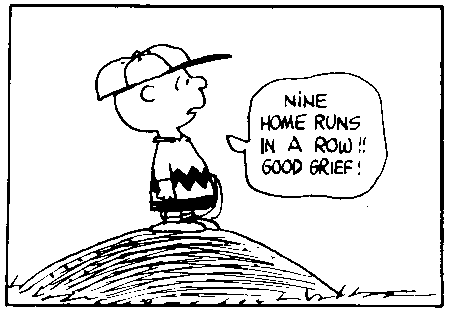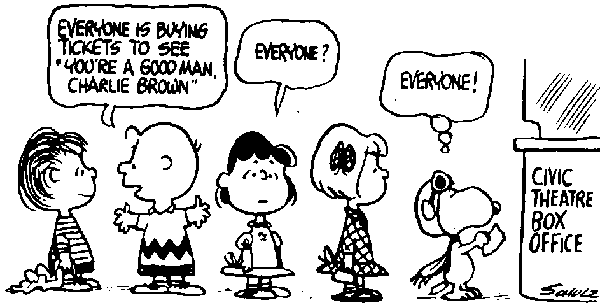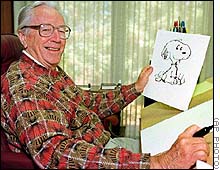






Charles Monroe Schulz was born in Minneapolis, Minnesota on November 22, 1922. While a young boy, he fancied reading the comic strips and began doing little drawings of his own, showing an early talent.
His favorite comic strip character was Popeye (drawn by the great E.C. Segar, whose biography will soon appear online) and in school, he frequently made drawings of Popeye for classmates. While he was still in high school, Schulz decided to take a correspondence course in cartooning, which he reportedly completed.
In 1943 young Charles was drafted and shipped off to Europe. later that year however his mother lost her fight with cancer and Charles returned, with a sergeant's rank, to St.Paul.
After his return he began cartooning for different publishers, even having some work published in one of the most famous magazines in history, the Saturday Evening Post. To many artists, having one cartoon published in that magazine would have been a career event. His work appeared in several issues!
In 1949, he began illustrating a one panel strip called Li'l Folks in the weekly magazine for the local St.Paul Pioneer-Press. When he did these early cartoons, they were signed "Sparky", a nickname given him by an uncle who himself was smitten by the newly introduced horse in the Barney Google comic strip.
In 1950 Charles felt it was time. He submitted his cartoon to the various comic strip syndicates and eventually was contacted by United Press Syndicate which offered him a contract, which itself had requested that the strip be redesigned in a multi panel format and renamed Peanuts.
The Peanuts daily strip made it's first appearance on October 2, 1950, but not to immediate success! By the end of 1953 it was still only appearing in just over fifty papers, whereas by comparison the Dick Tracy and Blondie strips were in over three hundred newspapers. In 1952 the Sunday page debuted in ten papers.
In 1955 however, even though the public at large had not yet caught "Peanuts fever" Schulz was awarded the National Cartoonists Society's "Reuben Award".
In 1957 the Rhinehart Company began releasing peanuts reprints in books, which were soon followed by many paperbacks and suddenly a floodgate opened, and circulation doubled!
Schulz again won the Reuben Award in 1964, and the following year Peanuts made its television debut in a prime time cartoon special that itself was not only a huge success but resulted in an Emmy award. This classic Christmas cartoon is an absolutely wonderful production, and is still shown frequently during the winter season. This was followed by a successful Broadway play in 1967. "You're A Good Man Charlie Brown" ran for four years, so it was only natural that Peanuts would work it's way to the silver screen and in 1970 "A Boy Named Charlie Brown" appeared at New York's Radio City.

From the beginning Peanuts, much like Blondie, has been a microcosim of American life, echoing American cynicism in it's showcasing of Charlie Brown's constant failures, resulting in his continual befuddlement.
Of course the other star of the strip, the indomitable Snoopy and his Red Baron episodes invigorate the dour tone of the strip itself.
In the almost six decades since the strip's first appearance, the Peanuts characters have been on the big and small screen, in books reprinting their adventures and in tv commercials hawking insurance of all things, every form of print publication imaginable and until the final strip appeared, the strip reportedly was syndicated in thousands(!) of papers.
In early January 2000, "Sparky" announced he was going to retire the Peanuts strip on February 13, 2000 so that he could focus his time on beating the colon cancer he had been diagnosed with. In an unusual twist of fate, Schulz passed away in his sleep during the night before the last strip could appear.

*
This site created & maintained by Graffix Multimedia